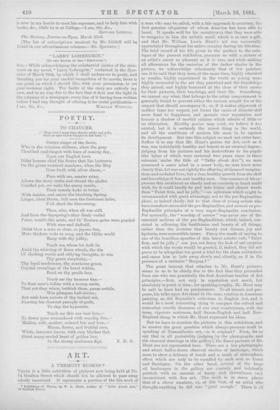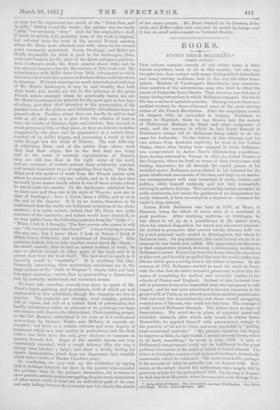ART.
A VERMONT RUSKIN,* Lana is a little exhibition of pictures now being held at No. 11 Grafton Street which should not be allowed to pass away wholly unnoticed. It represents a portion of the life-work of " Exhibition of Works, by W. L. aunt, Author or " Talks About Art," 14 Grafton Strout, a man who may be called, with a fair approach to accuracy, the- first genuine oil-painter of whom America has been able to boast. It speaks well for, his countrymen that they wore able to recognise in him the artistic merit which is so rare a gift,. and that Mr. William Lewis Hunt's art was universally appreciated throughout his native country during his life-time. The brief record of his life given in the preface to the cata- logue of the present exhibition, presents us with a picture of an artist's career as pleasant as it is rare, and while making all allowances for the omission of the darker shades in the picture, we acknowledge reluctantly that of few painters can it be said that they were, at the same time, highly educated as youths, highly experienced in the world as young men, highly successful in the art they practised and the friendships they gained, and highly honoured at the close of their career for their pictures, their teachings, and their life. Something,. we cannot say what, that belongs to the artist temperament is generally found to prevent either the success sought for or the• . respect that should accompany it; or, if it makes shipwreck of neither fame nor respect, yet forms the cause of disaster still more fatal to happiness, and spreads over reputation and
honour a shadow of morbid sadness which admits of little or no alleviation. Healthy genius may exist, we believe it 1ue
existed, but it is certainly the rarest thing in the world,. and all the conditions of modern life seem to be against its development. But into this subject we need not enter here.. Suffice it to say that Mr. Hunt's genius for Art, such as it was, was indubitably healthy and honest to an unusual degree ; judging from his pictures and his instructions to his pupils (the latter of which were reviewed two years since in these
columni,—under, the title of "Talks about Art "), no man.
possessed a saner mind in a saner body, no man knew more clearly that Art was not rightly the offspring of diseased imagina- tions and secluded lives, but a free, healthy growth from the skill and knowledge of free and healthy men. One sentence of his ex-- presses this sentiment as clearly and as concisely as heart could wish, for it could hardly be put into better and clearer words than "Paint firm, and be jolly,"—an aphorism which might be recommended with great advantage, not to the pre-Raphaelites alone, or indeed chiefly, but to that class of young artists who• have somehow succeeded the pre-Raphaelites, and arrived on pre Raphaelite principles at a very unpre-Raphaelite conclusion. For assuredly, the " worship of sorrow " was never one of the essential motives of the pre-Raphaelitism, which, indeed, con- sisted iu affirming the healthiness and beauty of all things, rather than the doctrine that beauty and disease, joy and hysteria, were convertible terms. Fancy the result of saying to- one of the beardless apostles of this latest artistic cult, " Paint firm, and be jolly ;" can you not fancy the look of sad surprise with which the words would be greeted, if, indeed, they did not prove to be altogether too great a trial for the sham enthusiast,• and cause him to fade away slowly and silently, as if in the presence of a veritable "Boojum ? "
The great interest that attaches to Mr. Hunt's pictures seems to us to be chiefly due to the fact that they proceeded train one who was practically the first American teacher of Art principles,—first, not only in reputation and merit, but absolutely in point of time; for speaking roughly, Mr. Hunt may be said to have had no predecessors. To all intents and pur poses, his talks upon Art stand in the same relation to American, painting as did Reynolds's criticisms to English Art, and it would be a most interesting thing to compare the refined and somewhat courtly discourse of our own countryman, with the. terse, vigorous sentences, half Saxon-English and half New- England slang, in which Mr. Hunt expressed his ideas.
13nt we have to mention the pictures iu this exhibition, aud to answer the great question which always presents itself in speaking of Transatlantic art,—is it original ? First, let us say that in all probability (judging by the photographs and the charcoal drawings in this gallery), the finest pictures of Mr.
Hunt are not represented here. There are a few photographs and about half-a-dozen charcoal studies of landscape, which seem to show a delicacy of touch and a truth of atmospheric effect which are only to be equalled by such men as Corot and Daubigny. On the other hand, several of the large oil landscapes in the gallery are coarsely and indolently painted, with an amount of hurry and slovenliness very inconsistent with fine art. The work is in many places that of a clever amateur, or, at the best, of an artist who thought anything he did was "good enough!' There is OS
we may use the expression) too much of the " Paint firm, and be jolly," feeling about the works ; the painter was too easily ." jolly," too carelessly " firm." And for the originality,—well, if truth be strictly told, probably none of the work is original, but reflected from the work of the several French masters whom Mr. Hunt most admired, and with whom he for several years constantly associated. Corot, Daubigny, and Millet are chiefly responsible for what is good in the landscapes ; Dela- croix and Couture for the style of the figure and genre pictures. Into Couture's studio Mr. Hunt entered about 1846, and he was already famous when the Revolution of 1848 broke out. His acquaintance with Millet dates from 1852, subsequent to which time he worked with that painter at Fontainebleau until his return to America. Without entering too much into technical criticism of Mr. Hunt's landscapes, it may be said broadly that both their faults and merits are due to the influence of the great French artists amongst whom he practically learnt his art. Mr. Hunt's landscapes are painted for the most part in low keys of colour, give their chief attention to the preservation of the general tone of the picture, and habitually subordinate form to general effect. Positive colour they can hardly be said to deal with at all, their aim is to give truly the relation of tone to tone, the truths of distance, light, and shadow; they are not so much pictures of this or that place, as they are delicate melodies suggested by the place and its appearance at a certain hour, touched off by skilful fingers, and possessing a truth of their owns though not the truth of Nature. The real difficulty of criticising them, and of the artists from whose work they had their origin, lies in the fact that not being real in the sense of accurate reproductions of Nature, they are still loss ideal in the right sense of the word, but are mixtures of certain natural facts arbitrarily selected, and certain dominant ways of regarding these facts. That Mr. Hunt took this method of work from the French artists with whom ho associated is only too certain, and so is the fact that lie could by no means decide which it was of those artists whom he would make his master. In the landscapes exhibited hero we have now and then one in the style of Troyon ; now one in that of Daubigny ; here a Corot, there a Millet, and so on to the end of the chapter. It is by no moans, therefore, to be understood that the works are deliberate imitations of the above masters ; it is quite certain, indeed, that Mr. Hunt was quite unaware of the similarity, and indeed would have denied it, as we may gather from the following sentence from his " Talks :"—
When I left it, I thought, ' The first person who comes in will say, "Oh, trying to paint like Corot I" ' I wasn't trying to paint like any one ; but I know when I look at Nature I think of Millet, Corot, Delacroix, and sometimes of Daubigny." This sentence, indeed, lets us into another secret about Mr. Hunt,— the secret, namely, that he had no actual method of work ; he says so plainly enough, in other parts of the book, and it is pretty clear from the work itself. The last word to apply to it correctly would be " masterly." It is anything but that. Generally interesting, often meritorious, sometimes (as in the large picture of the " Falls of Niagara") simply false and bad, but near masterly,—never, that is, approaching a determined. end, by perfectly understood and unwanted means.
We have left ourselves scarcely any space to speak of Mr. Hunt's figure-painting and portraiture, both of which are well represented in this exhibition, though the examples aro few iu number. The portraits are strongly, even roughly, painted, full of vigour, and full of a certain kind of penetration, but hardly satisfactory either as pictures or as paintings (we hope -our readers will observe the distinction). Flesh-painting proper, as the Old. Masters understood it (or even as it is understood now-a-days by Hennes, Watts, and Millais), is scarcely at- tempted ; but there is a certain sobriety and even dignity of -treatment which is a rare quality in portraiture, and the flesh suffers but little from the cold, grey shadows so common in modern French Art. Some of the smaller figures are very charmingly executed, with a rough delicacy (like the way a strong man touches a baby), and show a kindly feeling for simple domesticities, which does not degenerate into twaddle about baby's socks or Master Charles's pony. In conclusion, we may sum up the exhibition by saying that at perhaps interests us more in the painter who executed the pictures than in the pictures themselves, for it seems to show genuine artistic genius struggling, despite much admiration of other tneu's work, to beat out an individual path of its own, and only failing because its possessor saw too clearly the merits
of too many people. Mr. hunt wanted to be Couture, Dela- croix, and Millet rolled into one, and he ended by being—and it was no small achievement—a Vermont Ruskin.



































 Previous page
Previous page